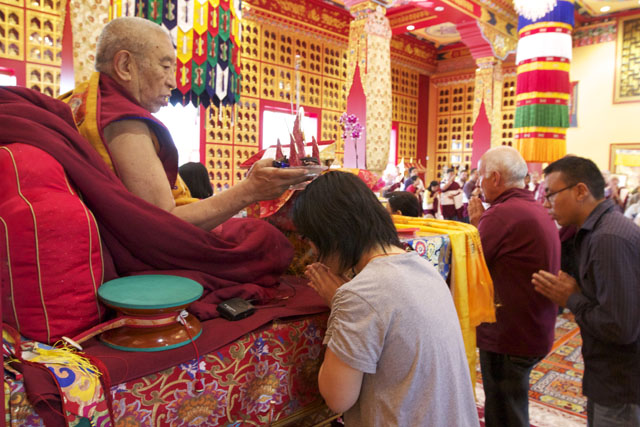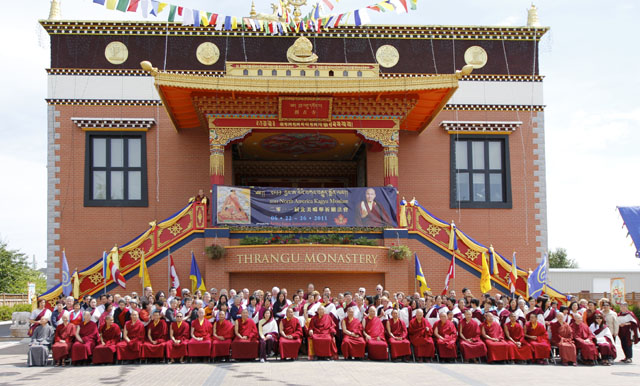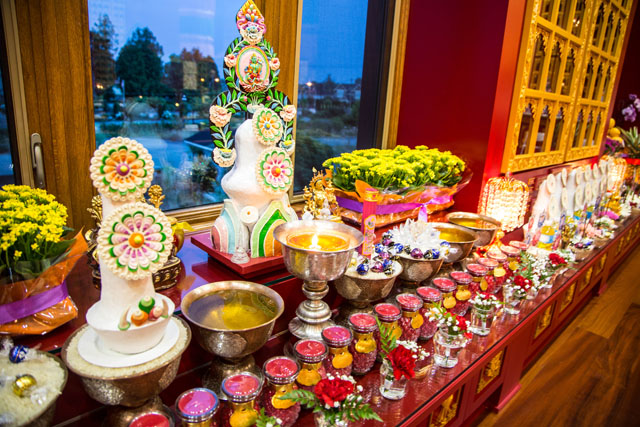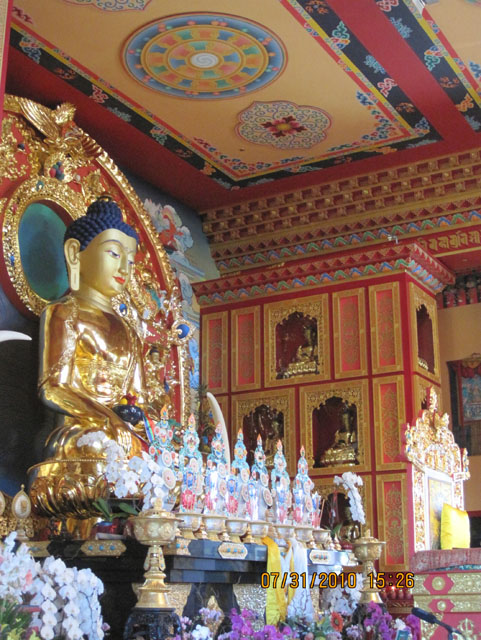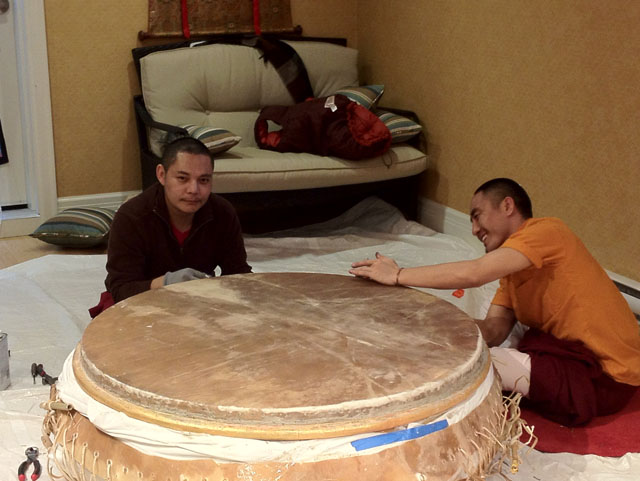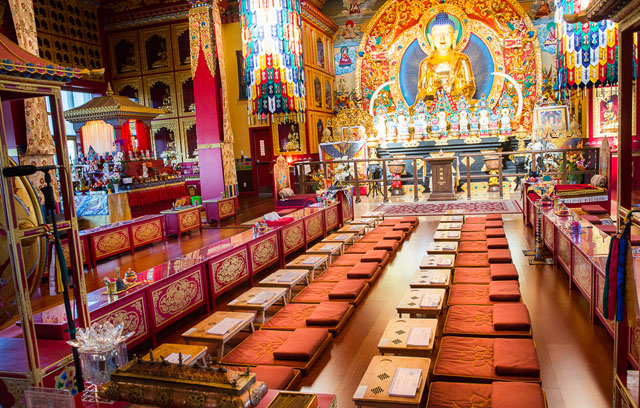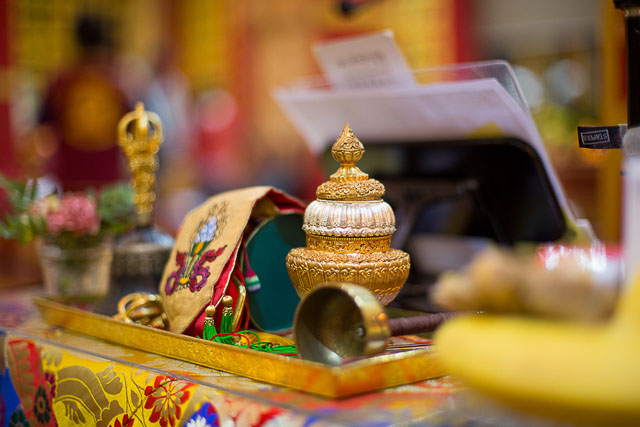Traditional Tibetan Values Upheld
At Canada’s Thrangu Monastery
Written by: Jackie Larm
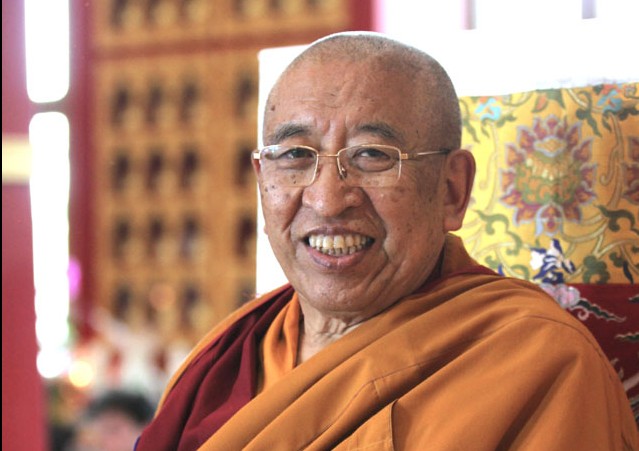
The Very Venerable Khenchen Thrangu Rinpoche.
Photos: Jackie Larm, Scott Pownall
Just three years after it opened, in July, 2010, Thrangu Monastery Canada has emerged as one of the most traditional Tibetan monasteries in North America.
The 35,000-square-foot monastery, the North American seat of Thrangu Rinpoche, was built in 23 months after many years of planning and working with the local government of Richmond, British Columbia and the larger community of the BC lower mainland.
This May, as we waited for Rinpoche to arrive, the sun was shining, the monks played their Tibetan horns (called gyaling), and the rest of us held colorful prayer flags adorned with auspicious symbols. We were happily celebrating the arrival of the supreme abbot of all the Thrangu monasteries worldwide, Thrangu Rinpoche (pronounced tran-goo rin-po-chay), who is our Buddhist teacher and guide.
Since the monastery’s opening celebration, Rinpoche has returned to reside and teach for a few months every year. Every year, when he arrives, we greet him with music and a procession to the shrine room.
However, this year was a little different. As Rinpoche, which means “precious one” in Tibetan, was led to his seat in the temple, he was visibly older, walking a little more slowly, favoring one leg and leaning on his attendant’s arm.
As is the case with all of us, his body is getting older. Seeing our 80-year-old teacher age is supposed to remind us that we’re all impermanent, which in turn encourages us to make the most of our lives – to not waste this precious human birth. Despite knowing this, seeing him aging makes me a little sad.
Thrangu Rinpoche is a practitioner of Tibetan Buddhism, as well as the supreme abbot of the Karma Kagyu lineage.
Thrangu Monastery Canada is part of Rinpoche’s extensive global network of Buddhist centers, monasteries, nunneries, and schools, and is among the most traditional Tibetan monasteries in the Pacific Northwest.
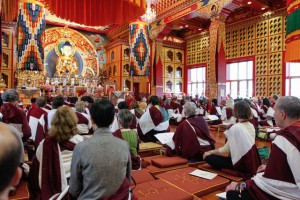
Thrangu Rinpoche giving teachings on Nagarjuna’s text, the “Fundamental Treatise of the Middle Way.”
Since its completion, it has hosted many public and private teaching events, all supporting the continuing strength of the lineage. In particular, Rinpoche has performed many empowerments, including the complete cycle required for participants in the traditional three-year meditation retreat.
The monastery is home to about 10 resident monks and, in the summer, to Rinpoche. While the heart of the monastery is Rinpoche, the embodiment of his presence is the colorful shrine room, anchored by a 13-foot statue of a seated Shakyamuni Buddha.
When Thrangu Rinpoche is looking after his students, monks and monasteries outside the Lower Mainland of British Columbia, as well as fulfilling his other spiritual responsibilities, the monastery is under the guidance of Lama Pema Tsewang and the resident khenpo, currently Khenpo Sonam.
During these periods, the monastery hosts many teachings, activities, and programs that they and the other monks oversee, such as daily and monthly prayers, Tibetan language classes, Buddhist classes and seminars, and Tibetan festivals. Lama Pema also travels in Canada and the United States to teach at Rinpoche’s centers in support of Rinpoche’s students’ study and practice.
Thrangu Rinpoche was born in Kham, Tibet, in 1933. When he first learned how to speak, he used to say to his parents, “I’ve got a white dog and a white mule. Bring me my dog and mule.”
As his family had neither a white dog nor a white mule, no one knew what he was talking about. To appease the child, his family brought home a stray white dog that was wandering around the area. The small boy stamped his feet in anger and cried, “You know this is not my dog! You are all very bad. You brought me this dog but it’s not mine.”
Shortly afterwards, when he was 3 years old, the young boy was taken to Thrangu Monastery in Tibet, the monastery of his previous eight incarnations. What do you think the child found at the monastery? A very old white dog and a very old white mule that had belonged to the previous Thrangu teacher, the eighth Thrangu tulku (recognized reincarnation) who had died several years before. The child recognized the animals and was very happy to be reunited with them.
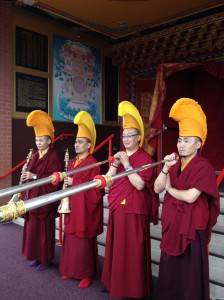
Resident monks at Thrangu Monastery Canada.
When he was 5 years old, the child was officially recognized as the ninth incarnation of the great Thrangu tulku. At the age of 7, his monastic education began. This ninth Thrangu Rinpoche soon became known as a great scholar within his tradition.
In 1959, he was forced to leave Tibet. Not dissuaded from his studies, he was eventually awarded the “Khenchen” degree, and continues to be regarded as one of the most learned scholars and meditators in his lineage.
As Rinpoche’s seat in North America, Thrangu Monastery Canada is an embodiment of traditional Tibetan values, art and design.
Each of the two side walls are enshrined with 500 Medicine Buddha statues, and opposite the shrine, adjacent to entrance, are 220 Amitabha statues. Behind the main Shakyamuni statue are the six ornaments representing the six paramitas. The 12 mandalas connected with the principal yidam practices of the lineage are painted on the ceiling.
The monastery’s six pillars are decorated with traditional Tibetan designs, topped with statues of Guru Rinpoche and Four-Arm Chenrezig. Additional gold Buddha statues, as well as mandalas and thangka paintings, cover the walls in a rich array.
Behind the monastery grows an organic orchard and vegetable garden that produces fruit and vegetables for the residents. The monastery also includes living quarters for the monastics, a library, offices, a kitchen and a dining area.
Thrangu monastery is located along what’s locally called the “Highway to Heaven,” a Richmond city road lined with churches, mosques, a Vedic center, a Sikh Gurdwara, a Jewish school, and other Buddhist temples.
Thousands of people come to the monastery every year to visit, to take pictures, to learn about Buddhism, to practice, to volunteer, and to celebrate special events.
Tibetan Buddhism is a tradition of Buddhism that is common in Tibet and nearby countries such as Bhutan, Nepal, and Mongolia. At present, there are four major schools within Tibetan Buddhism (Nyingma, Kagyu, Sakya, and Gelug).
Scholars from all lineages agree that the foundation of Buddhist practice is learning how to tame our minds. Taming our minds allows us to realize our true nature, which is compassionate, clear, and wise.
Other observations about life are also used to help us make positive decisions about what to adopt and what to reject. Knowing that we’re getting older encourages us to use our lifetime effectively. Knowing that all beings, including ourselves, want to be happy encourages us to help rather than harm others. In these ways, the Tibetan Buddhist schools share much of their basic philosophies, while having different teaching lineages and perhaps different points of emphasis both in practice and philosophy.
While Lama Pema, Khenpo Sonam, and the monks encourage us lay people to study, practice and work hard in our dharma activities, they also frequently advise us to “eat more, think less!”
As H.H. the 14th Dalai Lama, the most recognizable Tibetan Buddhist practitioner in the world, has said:
“This is my simple religion: There is no need for temples, there is no need for complicated philosophy. Our own brain, our own heart is the temple; the philosophy is loving kindness and compassion.”
Though I should be eating more and thinking less, I’ve thought a lot recently about Thrangu Rinpoche getting older, not to mention the aging of my family members, my friends, everyone…me. I suppose aging must simply be accepted. It’s one of those processes of nature that can’t be reversed or halted, and that could be welcomed if I learned how. I suppose that aging is like anything else in my environment that makes me uncomfortable: difficult tasks, people who don’t like me or hurt me, watching people suffer.
Shantideva, an 8th-century Indian Buddhist scholar, reminded students that there isn’t enough leather to cover the entire earth to make it comfortable to walk on. It is far more practical to wrap leather around one’s own feet.
In other words, one can’t spend his or her life trying to prevent difficulties from arising; a person can only deal with his or her own reactions in those situations. I think this is what our best life teachers (for me, Thrangu Rinpoche and Lama Pema) try to help us do: Sew the shoes that protect our feet as we walk in the world. Our teachers show us kindness and point out the truths of living.
I am grateful for all the truths that Rinpoche, Lama Pema, my loved ones, and all beings in my life, have shown me – even if it means remembering that today, I’m one day older.


